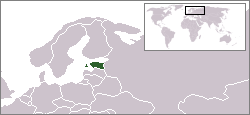Commune of the Working People of Estonia
| Commune of the Working People of Estonia | |||||
| Eesti Töörahva Kommuun | |||||
| Puppet state of Russian Soviet Socialist Republic | |||||
| |||||
 Location of Estonia in northern Europe. | |||||
| Capital | Narva | ||||
| Languages | Estonian Russian | ||||
| Government | Socialist republic | ||||
| Chairmana | |||||
| - | 1918–1919 | Jaan Anvelt | |||
| Legislature | Soviet council | ||||
| History | |||||
| - | Established | 29 November 1918 | |||
| - | Disestablished | 5 June 1919 | |||
| Currency | Russian ruble | ||||
| a. | Chairman (Esimees) of the Soviet of the Commune of the Working People of Estonia (Eesti Töörahva Kommuuni Nõukogu). | ||||
The Commune of the Working People of Estonia (Estonian: Eesti Töörahva Kommuun, initially Eesti Töörahwa Kommuuna; Russian: Эстляндская трудовая коммуна, ЭТК or ETK) was an unrecognised government claiming the Bolshevik-occupied parts of Republic of Estonia as its territories during the Estonian War of Independence and the Russian Civil War. The primary purpose of this entity, temporary by its very design, was to give the impression of an Estonian civil war in order to mask Soviet Russian aggression.[1]
Establishment and fall
The Commune was established in Narva on 29 November 1918, a day after its conquest by the Red Army. The Soviet authorities attempted to portray the offensive as a civil war but there was a lack of Estonian communists in the ranks of the occupation army and the so-called Estonian rifle regiments were in fact composed of Russians and other nationalities.[2] It was chaired by Jaan Anvelt for the duration of its existence. Within areas of their control, the Commune closed churches, nationalised industry and the banks[3] and outlawed representatives of the Provisional Government.[2]
The Russian offensive was initially successful and eventually reached as far as 34 kilometres from Tallinn. However, a counter-offensive begun on 7 January 1919 by the Estonian People's Force (Rahvavägi) under Commander-in-Chief Johan Laidoner eventually drove the Red Army out of Estonia, with international military aid primarily from the British Empire. The Commune was thus rendered defunct, claiming a government in exile in Pskov, then Luga and finally, from 17 May 1919, in Staraya Russa.
International recognition
The Russian Socialist Federative Soviet Republic (RSFSR) formally recognised the ETK on 7 December 1918 and remained the only government to do so.[4] At that time, Soviet Russia was itself not internationally recognised. One of the first international treaties recognising Russia's Soviet government as legitimate was the Treaty of Tartu concluding the Estonian War of Independence in 1920.
Massacres
The regime instituted a dictatorial reign of terror.[5] The terror was staged in two waves, the first from October 1917 to February 1918 and a second more brutal wave from November 1918 to January 1919.[6] A considerable number of people were arrested in Tartu in December 1919 and a number of German estate owners were shot on the frozen river on January 9th, 1919.[6] Just before Tartu was liberated the Communists staged a blood bath in the basement of a town bank,[6] among their victims were Bishop Platon, the priest Sergei Florinski and the pastor Traugott Hahn.[6] Over 500 people lost their lives.[7]
Members of the Commune
- Jaan Anvelt – chairman and military
- Viktor Kingissepp – interior (actually underground in Estonia, Johannes Käspert acting for him)
- Hans Pöögelmann – economic affairs
- Artur Vallner – culture and public education
- Johannes Mägi – foreign affairs (from 20 December 1918 Max-Alfred Trakmann) and state control (later Karl Mühlberg)
- Rudolf Vakman – social insurance (acting Otto Rästas)
- Johannes Käspert – secretary
Soviet authorities executed most of the members during the Great Purge.[8]
See also
- Estonian War of Independence
- Estonian Soviet Socialist Republic
- Latvian Socialist Soviet Republic
- Finnish Socialist Workers' Republic
- Finnish Democratic Republic
- Mass killings under Communist regimes
Notes
- ↑ Eesti ajalugu, a textbook for grade 11 by Küllo Arjakas, Mati Laur, Tõnis Lukas and Ain Mäesalu; Koolibri, Tallinn 1991; p. 261.
- ↑ 2.0 2.1 Brüggemann, Karsten (29 August 2008). ""Foreign Rule" during the Estonian War of Independence 1918–1920: The Bolshevik Experiment of the "Estonian Worker's Commune"". Journal of Baltic Studies (Routledge) 37 (2): pp210–226. doi:10.1080/01629770608628880.
- ↑ Miljan, Toivo (2004). Historical Dictionary of Estonia. Scarecrow Press. p. 226. ISBN 9780810865716.
- ↑ Eesti ajalugu, a textbook for grade 11 by Küllo Arjakas, Mati Laur, Tõnis Lukas and Ain Mäesalu; Koolibri, Tallinn 1991; p. 263.
- ↑ Miljan, Toivo (2004). Historical Dictionary of Estonia. European Historical Dictionaries 43. The Scarecrow Press. p. 226. ISBN 0810849046.
- ↑ 6.0 6.1 6.2 6.3 Von Rauch, Georg (2006). The Baltic States - The Years of independence 1917 - 1940. Hurst & Company. pp. 58–59. ISBN 1850652333.
- ↑ Tannberg, Tonu; Maesalu, Ain; Lukas, Tonis; Mati Laur, Ago Pajur (1997). History of Estonia (2nd ed.). Avita. p. 212. ISBN 9985206061.
- ↑ Kaljuvee, Ardo (22 September 2007). "Hea kommunist on surnud kommunist". Eesti Päevaleht (in Estonian). Retrieved 7 March 2013.
References
- Szajkowski, Bogdan. The Establishment of Marxist Regimes. London: Butterworths, 1982. p. 21-22. (ISBN 0-408-10834-7)
- The Baltic States from 1914 to 1923: The First World War and the Wars of Independence PDF (1.24 MiB) in Baltic Defence Review, No.8, Volume 2/2002.
External links
- Eesti Töörahva Kommuun
- Jaan Anvelt at arhiiv.ee.
- Jaan Anvelt at postimees.ee.
